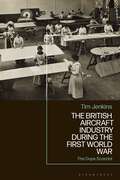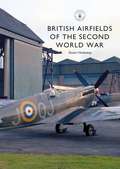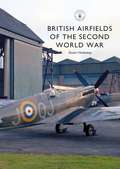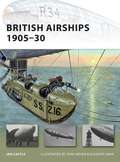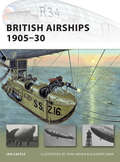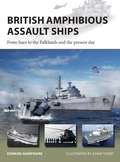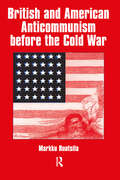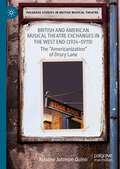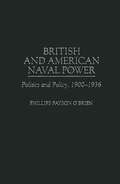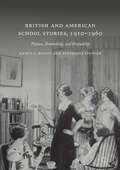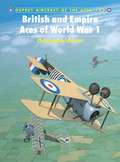- Table View
- List View
The British Aircraft Industry during the First World War: The Dope Scandal
by Dr Tim JenkinsIn this book, Tim Jenkins examines the factory worker poisonings and suspect government procurement procedures that resulted in Allied success in the air during First World War.The early development of aircraft during World War I was an important yet dangerous part of the war effort seen in the First World War and although many descriptions of daring aerial combat have been written, the risk to those involved in the manufacture of such machines remains less well known. Tetrachlorethane, a poisonous solvent contained in aircraft dope, was responsible for a number of civilian deaths in aircraft factories and although the British knew the substance to be lethal, they were much slower than their American and German counterparts in sourcing alternatives. In this groundbreaking book, Tim Jenkins explores the use of Tetrachlorethan and brings to light the concerns and warnings voiced by the international medical profession. His examination considers the government's reasons for its use of the poisonous solvent to create a compelling yet scholarly account which takes in corruption, negligence and wartime manufacture. This book will be vital to scholars studying military production during the First World War.
British Airfields of the Second World War (Shire Library)
by Stuart HadawayThe Second World War airfields peppered around Britain are among the most visible and widespread reminders of this devastating conflict. Some are now almost forgotten or built over; others have become museums, industrial estates or parkland; and some have been adapted and remain in operation today. In this beautifully illustrated history, aviation historian Stuart Hadaway explains the crucial part airfields played between 1939 and 1945, detailing their construction and expansion; their facilities and equipment; the many functions they housed from command and control to maintenance and bomb-loading; how the airfields were used both for defence and offence; and how they changed during the war. He also explores what life was like on the airfields, as well as listing some of the remaining sites and what can be seen today.
British Airfields of the Second World War (Shire Library)
by Stuart HadawayThe Second World War airfields peppered around Britain are among the most visible and widespread reminders of this devastating conflict. Some are now almost forgotten or built over; others have become museums, industrial estates or parkland; and some have been adapted and remain in operation today. In this beautifully illustrated history, aviation historian Stuart Hadaway explains the crucial part airfields played between 1939 and 1945, detailing their construction and expansion; their facilities and equipment; the many functions they housed from command and control to maintenance and bomb-loading; how the airfields were used both for defence and offence; and how they changed during the war. He also explores what life was like on the airfields, as well as listing some of the remaining sites and what can be seen today.
British Airships 1905–30 (New Vanguard)
by Tony Bryan Ian CastleThis book reveals the fascinating story of the cat and mouse duel between the airship and another pioneering form of technology – the submarine during World War 1. Detailed cut-away drawings reveal the design and development of the airship, during and after the war, whilst full-colour illustrations depict the airship in dramatic action shots. A tragic accident in 1930 brought the airship's military service to an end, resulting in a tiny window in which they were used and little acknowledgement over the years. Ian Castle gives deserved attention to an aeronautical wonder that for a short amount of time played a crucial service to the defence of Britain.
British Airships 1905–30 (New Vanguard)
by Tony Bryan Ian CastleThis book reveals the fascinating story of the cat and mouse duel between the airship and another pioneering form of technology – the submarine during World War 1. Detailed cut-away drawings reveal the design and development of the airship, during and after the war, whilst full-colour illustrations depict the airship in dramatic action shots. A tragic accident in 1930 brought the airship's military service to an end, resulting in a tiny window in which they were used and little acknowledgement over the years. Ian Castle gives deserved attention to an aeronautical wonder that for a short amount of time played a crucial service to the defence of Britain.
British America, 1500-1800: Creating Colonies, Imagining an Empire (1st edition)
by Steven SarsonBritish America combines the histories of colonies and empire - usually distinct fields of enquiry - in a sweeping introduction to and interpretation of the British-American New World. This book argues that while settlers created colonies, the early empire remained a largely imaginary construct.Writers, explorers, and colonial proprietors imagined colonies and empire as corporate entities serving various political, religious, and social purposes. Yet, these visions were invariably usurped by settlers who created colonies according to principles of political autonomy and individual independence based on private property, even if the liberties their ideals engendered entailed the extermination and expulsion of Native Americans and the enslavement of Africans. English and then British governments encouraged autonomy by granting colonies as private proprietorships, and then accommodating the settler-led polities that subsequently emerged. When Britain finally imposed a vision of empire from the 1760s, the settlers declared their independence, forcing Britain to consider imperialism as something much more than imaginary. This account examines the way in which the New World was invented and offers a convincing analysis of the loss of the First British Empire.
British America, 1500-1800: Creating Colonies, Imagining an Empire (1st edition) (PDF)
by Steven SarsonBritish America combines the histories of colonies and empire - usually distinct fields of enquiry - in a sweeping introduction to and interpretation of the British-American New World. This book argues that while settlers created colonies, the early empire remained a largely imaginary construct.Writers, explorers, and colonial proprietors imagined colonies and empire as corporate entities serving various political, religious, and social purposes. Yet, these visions were invariably usurped by settlers who created colonies according to principles of political autonomy and individual independence based on private property, even if the liberties their ideals engendered entailed the extermination and expulsion of Native Americans and the enslavement of Africans. English and then British governments encouraged autonomy by granting colonies as private proprietorships, and then accommodating the settler-led polities that subsequently emerged. When Britain finally imposed a vision of empire from the 1760s, the settlers declared their independence, forcing Britain to consider imperialism as something much more than imaginary. This account examines the way in which the New World was invented and offers a convincing analysis of the loss of the First British Empire.
British America, 1500-1800: Creating Colonies, Imagining an Empire (PDF)
by Steven SarsonBritish America combines the histories of colonies and empire - usually distinct fields of enquiry - in a sweeping introduction to and interpretation of the British-American New World. This book argues that while settlers created colonies, the early empire remained a largely imaginary construct.
British America, 1500-1800: Creating Colonies, Imagining an Empire (PDF)
by Steven SarsonBritish America combines the histories of colonies and empire - usually distinct fields of enquiry - in a sweeping introduction to and interpretation of the British-American New World. This book argues that while settlers created colonies, the early empire remained a largely imaginary construct.
British-American Relations 1917-1918: The Role of Sir William Wiseman. Supplementary Volume to The Papers of Woodrow Wilson (PDF)
by Wilton B. FowlerThroughout the First World War Woodrow Wilson considered Britain's ambitions in the war as objectionable as Germany’s. He repeatedly expressed distrust of the British government’s motives; for their part, the British chafed at Wilson’s idealism and despised his aloofness from the Allies. Sir William Wiseman played an extraordinary part as the behind- the-scenes liaison between the two major powers. Acting as a personal friend and confidant of Wilson’s adviser, Colonel House, Wiseman is credited with keeping animosities in check between America and Great Britain, and for helping to establish coalition diplomacy, which was new to the U.S. in 1917-1918, though within 25 years it became a permanent characteristic of American foreign policy. British-American Relations, 1917-1918 provides fascinating insights not only into Wiseman’s role but into the entire diplomacy of the Wilson period.Originally published in 1969.The Princeton Legacy Library uses the latest print-on-demand technology to again make available previously out-of-print books from the distinguished backlist of Princeton University Press. These editions preserve the original texts of these important books while presenting them in durable paperback and hardcover editions. The goal of the Princeton Legacy Library is to vastly increase access to the rich scholarly heritage found in the thousands of books published by Princeton University Press since its founding in 1905.
British Amphibious Assault Ships: From Suez to the Falklands and the present day (New Vanguard)
by Edward HampshireAmphibious assault ships have been at the centre of nearly all of Britain's expeditionary campaigns since World War II, from the Suez crisis of 1956 to operations as far afield as Borneo (1963–66), the Falklands (1982), Sierra Leone (2000) and Iraq (2003). In major operations such as Suez and the Falklands, the use of amphibious assault ships was essential to the military success of the campaigns. The Suez Crisis saw two of the Royal Navy's former light fleet carriers converted into 'commando carriers' to specialise in amphibious warfare. In the 1960s these were followed by the famous Fearless class ships – the first purpose-built amphibious assault ships in the Royal Navy. With an internal dock, headquarters capability, and multiple landing craft, these 'Landing Platform Docks' were built to project power around the world. When the Falklands were invaded, HMS Fearless was the key to the successful landing in San Carlos. In the 1990s, a new generation was ordered: the helicopter carrier HMS Ocean and the Albion class LPDs. In recent years Ocean, Albion and Bulwark have been the largest fighting ships of the Royal Navy and have acted as the navy's flagships, as well as being perhaps the most versatile ships in the navy. This title is an essential guide to British Amphibious Assault Ships across the decades, from the mighty Fearless to the modern Albion. Packed with full-colour illustrations, contemporary photography, and detailed analysis, this definitive work explores the history, development, and deployment of the Royal Navy's front line.
British Amphibious Assault Ships: From Suez to the Falklands and the present day (New Vanguard #277)
by Edward HampshireAmphibious assault ships have been at the centre of nearly all of Britain's expeditionary campaigns since World War II, from the Suez crisis of 1956 to operations as far afield as Borneo (1963–66), the Falklands (1982), Sierra Leone (2000) and Iraq (2003). In major operations such as Suez and the Falklands, the use of amphibious assault ships was essential to the military success of the campaigns. The Suez Crisis saw two of the Royal Navy's former light fleet carriers converted into 'commando carriers' to specialise in amphibious warfare. In the 1960s these were followed by the famous Fearless class ships – the first purpose-built amphibious assault ships in the Royal Navy. With an internal dock, headquarters capability, and multiple landing craft, these 'Landing Platform Docks' were built to project power around the world. When the Falklands were invaded, HMS Fearless was the key to the successful landing in San Carlos. In the 1990s, a new generation was ordered: the helicopter carrier HMS Ocean and the Albion class LPDs. In recent years Ocean, Albion and Bulwark have been the largest fighting ships of the Royal Navy and have acted as the navy's flagships, as well as being perhaps the most versatile ships in the navy. This title is an essential guide to British Amphibious Assault Ships across the decades, from the mighty Fearless to the modern Albion. Packed with full-colour illustrations, contemporary photography, and detailed analysis, this definitive work explores the history, development, and deployment of the Royal Navy's front line.
British and American Anti-communism Before the Cold War
by Markku RuotsilaThis work examines in a comparative historical way the socialist, liberal and conservative strands of Anglo-American anticommunist thought before the Cold War. In so doing, this book provides us with an intellectual pre-history of Cold War attitudes and policy positions.
British and American Anti-communism Before the Cold War
by Markku RuotsilaThis work examines in a comparative historical way the socialist, liberal and conservative strands of Anglo-American anticommunist thought before the Cold War. In so doing, this book provides us with an intellectual pre-history of Cold War attitudes and policy positions.
British and American Commercial Relations with Soviet Russia, 1918-1924
by Christine A. WhiteWhite reassesses Anglo-American trade with Soviet Russia immediately following the Bolshevik Revolution to show that, unlike diplomatic relations, commercial ties were not severed by ideological differences. She argues that British and American trade with Russia resumed soon after the Bolsheviks' rise to power and that this period of trade had a significant effect on future commerce.Originally published in 1992.A UNC Press Enduring Edition -- UNC Press Enduring Editions use the latest in digital technology to make available again books from our distinguished backlist that were previously out of print. These editions are published unaltered from the original, and are presented in affordable paperback formats, bringing readers both historical and cultural value.
British and American Foundings of Parliamentary Science, 1774–1801 (International Relations and the European Atlantic World, 1660-1830)
by Peter J. AschenbrennerUpon declaring independence from Britain in July 1776, the United States Congress urgently needed to establish its credentials as a legitimate government that could credibly challenge the claims of the British Crown. In large measure this legitimacy rested upon setting in place the procedural and legal structures upon which all claims of governmental authority rest. In this book, Aschenbrenner explores the ways in which the nascent United States rapidly built up a system of parliamentary procedure that borrowed heavily from the British government it sought to replace. In particular, he looks at how, over the course of twenty-five years, Thomas Jefferson drew upon the writings of the Chief Clerk of the British Parliament, John Hatsell, to frame and codify American parliamentary procedures. Published in 1801, Jefferson’s Manual of Parliamentary Practice for the Use of the Senate of the United States presents rules, instances, citations and commentary as modern readers would expect them to appear, quoting Hatsell and other British authorities numerous times. If the two nations suffered any unpleasant relations in the First War for American Independence - Aschenbrenner concludes - one would be hard pressed to detect it from Jefferson’s Manual. Indeed, direct comparison of the House of Commons and the Continental Congress shows remarkable similarities between the ambitions of the two institutions as they both struggled to adapt their political processes to meet the changing national and international circumstances of the late-eighteenth century.
British and American Foundings of Parliamentary Science, 1774–1801 (International Relations and the European Atlantic World, 1660-1830)
by Peter J. AschenbrennerUpon declaring independence from Britain in July 1776, the United States Congress urgently needed to establish its credentials as a legitimate government that could credibly challenge the claims of the British Crown. In large measure this legitimacy rested upon setting in place the procedural and legal structures upon which all claims of governmental authority rest. In this book, Aschenbrenner explores the ways in which the nascent United States rapidly built up a system of parliamentary procedure that borrowed heavily from the British government it sought to replace. In particular, he looks at how, over the course of twenty-five years, Thomas Jefferson drew upon the writings of the Chief Clerk of the British Parliament, John Hatsell, to frame and codify American parliamentary procedures. Published in 1801, Jefferson’s Manual of Parliamentary Practice for the Use of the Senate of the United States presents rules, instances, citations and commentary as modern readers would expect them to appear, quoting Hatsell and other British authorities numerous times. If the two nations suffered any unpleasant relations in the First War for American Independence - Aschenbrenner concludes - one would be hard pressed to detect it from Jefferson’s Manual. Indeed, direct comparison of the House of Commons and the Continental Congress shows remarkable similarities between the ambitions of the two institutions as they both struggled to adapt their political processes to meet the changing national and international circumstances of the late-eighteenth century.
The British and American Intelligence Divisions in Occupied Germany, 1945–1955: A Secret System of Rule
by Luke Daly-GrovesThis book provides the first history of the British and American Intelligence Divisions (IDs) in occupied Germany and the liaison between them. It reveals that after the fall of Adolf Hitler’s Third Reich, much of Germany was controlled by an Anglo-American secret system of rule which was the real backbone of the occupation and largely explains its successful outcomes. Based in Heidelberg, the American ID was the senior American military intelligence organisation in occupied Germany, responsible for the security of American forces in Europe. The British ID, based in Herford, was a purpose-built intelligence organisation designed to ensure the security of the British Zone of Germany and to help achieve the Allied occupation objectives. The IDs undertook military, scientific, security, political, and state-building intelligence tasks which each form the focus of a chapter in this book.
British and American Musical Theatre Exchanges in the West End: The “Americanization” of Drury Lane (Palgrave Studies in British Musical Theatre)
by Arianne Johnson QuinnThis monograph centres on the history of musical theatre in a space of cultural significance for British identity, namely the Theatre Royal, Drury Lane, which housed many prominent American productions from 1924-1970. It argues that during this period Drury Lane was the site of cultural exchanges between Britain and the United States that were a direct result of global engagement in two world wars and the evolution of both countries as imperial powers. The critical and public response to works of musical theatre during this period, particularly the American musical, demonstrates the shifting response by the public to global conflict, the rise of an American Empire in the eyes of the British government, and the ongoing cultural debates about the role of Americans in British public life. By considering the status of Drury Lane as a key site of cultural and political exchanges between the United States and Britain, this study allows us to gain a more complete portrait of the musical’s cultural significance in Britain.
British and American Naval Power: Politics and Policy, 1900-1936 (Praeger Studies in Diplomacy and Strategic Thought)
by Phillips O'BrienU.S. and British naval power developed in quite different ways in the early 20th century before the Second World War. This study compares, contrasts, and evaluates both British and American naval power as well as the politics that led to the development of each. Naval power was the single greatest manifestation of national power for both countries. Their armies were small and their air forces only existed for part of the period covered. For Great Britain, naval power was vital to her very existence, and for the U.S., naval power was far and away the most effective tool the country could use to exercise armed influence around the world. Therefore, the decisions made about the relative strengths of the two navies were in many ways the most important strategic choices the British and American governments ever made. An important book for military historians and those interested in the exercise and the extension of power.
British and American News Maps in the Early Cold War Period, 1945–1955: Mapping the "Red Menace" (Palgrave Studies in the History of the Media)
by Jeffrey P. StoneDuring the early years of the Cold War, England and the United States both found themselves reassessing their relationship with their former ally the Soviet Union, and the status of their own “special relationship” was far from certain. As Jeffrey P. Stone argues, maps from British and American news journals from this period became a valuable tool for relating the new realities of the Cold War to millions of readers. These maps were vehicles for political ideology, revealing both obvious and subtle differences in how each country viewed global geopolitics at the onset of the Cold War. Richly illustrated with news maps, cartographic advertisements, and cartoons from the era, this book reveals the idiomatic political, cultural, and material differences contributing to these divergent cartographic visions of the Cold War world.
British and American School Stories, 1910–1960: Fiction, Femininity, and Friendship
by Nancy G. Rosoff Stephanie SpencerThis book examines school and college fiction for girls in Britain and the United States, written in the first half of the twentieth century, to explore the formation and ideologies of feminine identity. Nancy G. Rosoff and Stephanie Spencer develop a transnational framework that recognises how both constructed and essential femininities transcend national boundaries. The book discusses the significance and performance of female friendship across time and place, which is central to the development of the genre, and how it functioned as an important means of informal education. Stories by Jessie Graham Flower, Pauline Lester, Alice Ross Colver, Elinor Brent-Dyer, and Dorita Fairlie Bruce are set within their historical context and then used to explore aspects of sociability, authority, responsibility, domesticity, and possibility. The distinctiveness of this book stems from the historical analysis of these sources, which have so far primarily been treated by literary scholars within their national context.Winner of the History of Education Society Anne Bloomfield Prize for the best book on history of education published in English 2017-19
The British and Cyprus: An Outpost of Empire to Sovereign Bases, 1878-1974
by Mark SimmonsThis is the story of the British involvement with the island of Cyprus over a hundred years. Since World War I, Cyprus has played a key role in British defence strategy. After the withdrawal from Egypt the island became the British Middle East headquarters. Britain retains two sovereign bases on the island, and it has become a favourite with UK tourists. Much of the tale is oral history, told in the words of the people who served the British Crown on Cyprus, civil and military; many relate their experiences first hand. There are fascinating accounts from Royal Marine Commandos, and soldiers of the Parachute Regiment along with other Army units, and the thoughts of sailors and airmen, and civilians of the Colonial Service and those who served in the Cyprus Police, of service wives and writers, most not published before.
British and Empire Aces of World War 1 (Aircraft of the Aces)
by Christopher Shores Mark RolfeAt the outset of World War I the British had some 110 assorted aircraft, used mostly for the visual reconnaissance role. With the advent of faster and more agile single-seaters, the Allies and their adversaries raced to outdo each other in the creation of genuinely effective fighters with fixed forward-firing machine gun armament. It was not until 1917 that the British developed a truly effective interrupter gear, which paved the way for excellent single seaters such as the Sopwith Triplane Camel and the RAF S.E.5., later joined by the Bristol F.2B the war's best two-seat fighter. This volume traces the rapid development of the fighter in World War I and the amazing exploits of the British and Empire aces who flew them.
